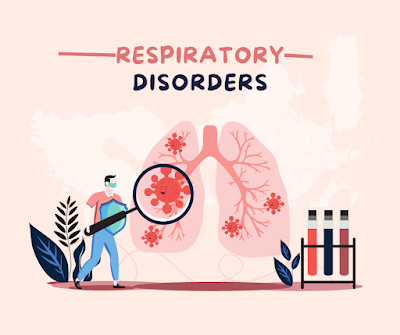Respiratory disorders include a large number of medical conditions that affect the respiratory system. These disorders can have a great impact on someone's quality of life. In some cases, these disorders may lead to mortality. This article will uncover various respiratory disorders, their causes, symptoms, and how they can be treated.
Importance of Healthy Lungs
Common Respiratory Disorders
Asthma
Asthma is a chronic respiratory disorder that affects the air passageway in the lungs. It is a form of allergy that is characterized by inflammation of the bronchi, increased mucous production, and constriction of the airways. Asthma patients' bronchi and bronchioles are sensitive to various allergens like smoke, dust, pollens, perfumes, etc. Patients with asthma often experience episodes of wheezing, shortness of breath, coughing, and chest tightness. While asthma has no cure, it can be managed effectively with medications and lifestyle adjustments. Its medication includes chemicals to dilate the airways, which are given in the form of inhalers.
Chronic Obstructive Pulmonary Disease (COPD)
COPD is an umbrella term for several chronic lung diseases,
including chronic bronchitis and emphysema. It is typically caused by long-term
exposure to irritants like cigarette smoke and air pollution. Symptoms of COPD
include persistent cough, excessive mucus production, and reduced lung
function.
Pneumonia
Lung cancer
Interstitial Lung disease
This group of lung disorders primarily affects the
interstitium, which is the tissue that supports the alveoli (tiny air sacs in
the lungs). Interstitial lung disease can result from exposure to toxins,
certain medications, and autoimmune conditions. Symptoms include a persistent
cough and difficulty breathing.
Pulmonary Hypertension
Pulmonary hypertension is a condition where the blood
pressure in the pulmonary arteries becomes elevated, putting extra strain on
the heart. This condition can result from various underlying issues, and its
symptoms include shortness of breath and fatigue.
Causes of Respiratory Disorders
1. Smoking
Tobacco smoke is a primary cause of many respiratory
disorders, particularly lung cancer and COPD.
2. Air Pollution
Exposure to indoor and outdoor air pollutants can lead to respiratory problems. Individuals living in heavily polluted areas are at a higher risk.
3. Occupational Hazards
Certain occupations, such as coal mining or asbestos handling, can expose workers to substances that may lead to respiratory issues.
4. Infections
Viral, bacterial, and fungal infections can damage the respiratory system, causing conditions like pneumonia and tuberculosis.
5. Allergies
Allergic reactions to substances like pollen, dust mites, and pet dander can result in conditions like asthma and allergic rhinitis.
6. Genetics
Some respiratory disorders have a genetic component, meaning they can run in families.
Symptoms of Respiratory Disorders
The symptoms of respiratory disorders can vary widely depending on the specific condition. However, common symptoms include:
- Shortness of breath
- Coughing
- Wheezing
- Chest pain or discomfort
- Excessive mucus production
- Fatigue
- Bluish lips or fingertips (a sign of oxygen deprivation)
It's important to note that early detection and diagnosis are crucial for effectively managing respiratory disorders. If you or a loved one experiences any of these symptoms, consult a healthcare professional promptly.
Diagnosis and Treatment
The diagnosis of respiratory disorders often involves a combination of medical history, physical examinations, and diagnostic tests. Common diagnostic tests include:
1. Chest X-ray
X-rays provide images of the lungs and can help identify abnormalities, such as tumors or infections.
2. Pulmonary Function Tests (PFTs)
PFTs assess lung function, measuring factors like lung capacity and airflow.
3. CT Scans
CT scans can provide detailed images of the lungs, making them valuable for diagnosing conditions like lung cancer and interstitial lung disease.
4. Bronchoscopy
Bronchoscopy involves inserting a thin, flexible tube into the airways to examine them closely and collect tissue samples for analysis.
Once diagnosed, treatment plans are tailored to the specific respiratory disorder. Here are some common treatment approaches:
1. Medications
Many respiratory disorders can be managed with medications such as bronchodilators, steroids, and antibiotics.
2. Lifestyle Changes
In cases like asthma and COPD, lifestyle changes, such as smoking cessation and avoiding known triggers, can be highly effective.
3. Oxygen Therapy
Some individuals with severe respiratory disorders require supplemental oxygen to maintain adequate oxygen levels in their blood.
4. Pulmonary Rehabilitation
This comprehensive program combines exercise, education, and support to help individuals improve their lung function and overall well-being.
5. Surgery
Surgery may be necessary for conditions like lung cancer or advanced emphysema.
Preventing Respiratory Disorders
Prevention is often the best approach when it comes to respiratory disorders. Here are some steps you can take to reduce your risk:
Quit Smoking: If you smoke, quitting is the single most effective way to protect your respiratory health.
Avoid Secondhand Smoke: Steer clear of environments where you are exposed to secondhand smoke.
Reduce Exposure to Pollutants: Take measures to reduce your exposure to indoor and outdoor pollutants, such as using air purifiers and avoiding heavily polluted areas.
Get Vaccinated: Vaccines can protect against respiratory infections like the flu and pneumonia.
Practice Good Hygiene: Wash your hands regularly and practice good respiratory hygiene, such as covering your mouth and nose when you cough or sneeze.
Stay Active: Regular exercise can help maintain lung health and improve overall well-being.
Follow Occupational Safety Guidelines: If you work in
an occupation with respiratory risks, adhere to safety guidelines and use
appropriate protective equipment.
Conclusion
Respiratory disorders encompass a wide range of conditions
that affect the lungs and the respiratory system. These disorders can have a
significant impact on one's quality of life and overall health. By
understanding the causes, symptoms, and treatment options for respiratory
disorders, individuals can take steps to protect their lung health and



.png)






If you have any doubt, let me know.